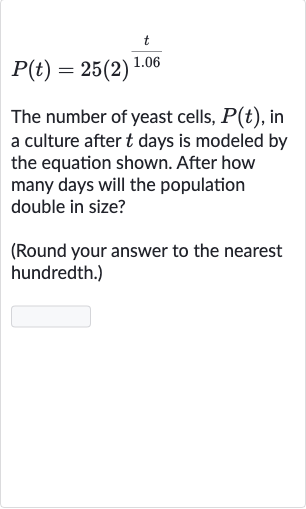Full solution
Q. The number of yeast cells, , in a culture after days is modeled by the equation shown. After how many days will the population double in size?(Round your answer to the nearest hundredth.)
- Identify initial population and doubling condition: Identify the initial population and the condition for doubling.The initial population is given by , which is since makes the exponent zero, and . To double, the population needs to reach .
- Set up equation for population doubling: Set up the equation to solve for the time when the population doubles.We need to find such that . So we set up the equation
50 50 25 25 2 2 1 1 06 06 - Isolate exponential part of the equation: Divide both sides of the equation by
25 25 \newline 50 25 = 25 ( 2 ) ( t 1.06 ) 25 \frac{50}{25} = \frac{25(2)^{\left(\frac{t}{1.06}\right)}}{25} 2 = 2 ( t 1.06 ) 2 = 2^{\left(\frac{t}{1.06}\right)} - Take logarithm of both sides: Take the logarithm of both sides to solve for
t t \newline log b ( a x ) = x log b ( a ) \log_b(a^x) = x \log_b(a) 2 2 log 2 ( 2 ) = log 2 ( 2 ( t 1.06 ) ) \log_2(2) = \log_2(2^{(\frac{t}{1.06})}) - Simplify logarithmic equation: Simplify the logarithmic equation.
\newline log 2 ( 2 ) = 1 \log_2(2) = 1 1 = t 1.06 1 = \frac{t}{1.06} t t - Multiply both sides to find
t t 1.06 1.06 t t 1 × 1.06 = t 1.06 × 1.06 1 \times 1.06 = \frac{t}{1.06} \times 1.06 t = 1.06 t = 1.06 - Round answer to nearest hundredth: Round the answer to the nearest hundredth as instructed.
\newline t t t = 1.06 t = 1.06
More problems from Write linear and exponential functions: word problems
QuestionGet tutor help
QuestionGet tutor help
QuestionGet tutor help
QuestionGet tutor help
QuestionGet tutor help
QuestionGet tutor help
QuestionGet tutor help
QuestionGet tutor help
QuestionGet tutor help
QuestionGet tutor help

